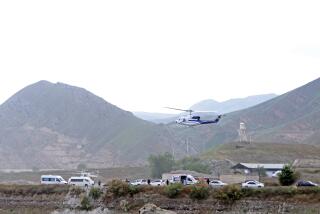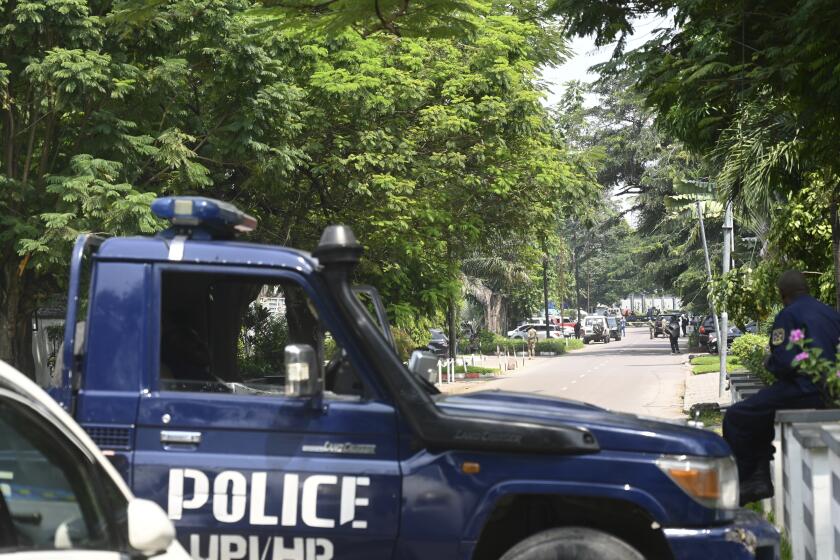Flaring Siberia Gas: Torches Light Way to Eco-Disaster : Environment: Watchdog group says fires in Russia’s main oil-producing area are threat on par with Kuwait.
When cosmonauts look down from their space station at Earth, they say the brightest spot they see is not a metropolis in America or Europe. It is the oil fields of Western Siberia, where thousands of wells flare off the natural gas they produce in giant wasteful torches.
“Torches burn across the globe but nowhere as much as in Siberia,” said Vladimir Ulyanov, chairman of the Tyumen Region Parliament. “Frankly, I’m surprised that world public opinion has been so quiet about this.”
Western Siberia--Russia’s main oil-producing region, remote and long out of reach deep inside the Soviet monolith--has drawn little attention from global environmental groups. Even now, with local watchdogs free to complain and the activist group Greenpeace beginning to send out feelers here, the area remains out of the international limelight.
But this, clearly, is a zone of virtually unchecked environmental damage--damage that affects the world outside as well. Members of the Social-Ecological Union, Russia’s biggest environmental group, estimate that the flares and frequent oil fires in Siberia pollute the atmosphere as badly as did the oil fires in Kuwait, ignited during the Persian Gulf War.
“I sat down and compared Kuwait’s fires with Western Siberia’s and they were about equivalent, the yearly amount,” environmentalist Vladimir Zamoysky said. “But in Siberia, the equivalent of the amount (of pollutants) released in Kuwait has been burnt every year for 20 years.
“My position,” he said, “is that there has been a clear under-evaluation of Western Siberia’s contribution to the greenhouse effect,” the buildup of gases in the atmosphere that traps the Earth’s heat and could cause global climate changes.
Experts at the Natural Resources Defense Council in Washington believe that comparing Siberia to the Kuwaiti fires is overstated. But research associate Kristen Suokko said: “The major effect (of flaring) is to contribute to carbon dioxide levels and global warming gases. That’s the major concern.”
Siberia’s torches, which burn off 16 billion cubic meters of gas every year, according to Russia’s energy minister, are also believed to contribute heavily to the depletion of the Earth’s ozone layer. Greenpeace warns that an ozone hole much like the one over Antarctica may be developing over the Northern Hemisphere.
More localized but with a far more immediate effect on humans and animals is the widespread oil leakage from decrepit pipelines and waste pools. It kills off fish and other aquatic life in Siberia’s rivers. For the native people here who depend on fishing and hunting, a river’s death can mean the end of a way of life.
Western Siberia, basically one gigantic swamp the size of Western Europe, is as critical to the Earth’s ecosystem as the rain forests of the Amazon, environmentalists say.
But no ruckus has been raised as parts of it have been poisoned. And local activists appear largely stymied, humbly grateful that at least they have a little more impact than before.
In Surgut, a regional oil center of 300,000, the 50-person state Committee for the Protection of the Environment--which is meant to serve as watchdog over oil and gas workers--openly concedes its ineffectiveness.
When they want to check out a reported spill somewhere in their immense territory, inspectors say they must ask an oil company to allow them space on a company helicopter so they can fly over the roadless swamp to the site. They have little equipment or money of their own; even their office space is granted by the oil company--inside one of the company’s main buildings.
“What can you do? There is that dependence,” inspector Galina Dubrovina said.
Under Russia’s new environmental laws, inspectors can levy large fines by Russian standards--up to about $20,000--on oil companies whose projects pollute, Dubrovina said. But in practice, inspectors said, many spills go undetected, often intentionally hidden by workers, and the oil companies usually manage to negotiate reductions in the fines.
Nina Rudalyova, another inspector, had just returned from a look at an accident site where workers’ carelessness and heavy rains led to a massive oil overflow near a well.
“The spill all went into the brooks that feed the Mokhovaya River, which had great fish,” she said. “Now, they’ve killed that river, no doubt about it.”
Oil spills also contribute to the gases sent into the atmosphere, because workers sometimes set them ablaze--illegally--to get rid of them.
An inspection by Greenpeace, the most active foreign environmental group in Russia, found oil spills widespread in the Surgut area, caused mainly by ruptures in aging, rusting pipelines and by devil-may-care workers overfilling pools of waste and runoff next to wells. Russian officials estimate that 10% of Siberia’s oil production is lost to spills and leaks, amounting to millions of tons.
“The impression is not of a major screw-up but rather of shoddy practices, complete lack of planning and universal carelessness,” said an internal Greenpeace report, discussing the causes of Siberian environmental damage.
Siberia’s natural gas torches and their tremendous wastefulness are symptoms of the merciless push by the Soviet Union in past decades to industrialize at breakneck pace.
In most parts of the world, natural gas released during drilling is either pumped back into the hole or utilized. The gas cannot be left alone because it impedes drilling and is explosive. It can be used to power energy plants and to produce fuel and other petrochemical products. But this takes enough planning and money to build pipelines or the facilities for using the gas not far from the oil well that produces it.
One of the World Bank’s central projects for Russia, now getting under way, is a plan to cut back on gas torches by building such local plants and pipelines. They could recover an estimated 6 billion cubic meters per year. It may cost up to $1.3 billion for the total project. But the money would soon be recouped with the saved gas and the oil products.
And the environment would benefit.
“It’s obvious the amount of gas flared influences the global climate,” said Vadim Voronin of the World Bank’s Moscow office. “That’s why it’s not just a local problem, but a global problem.”
Russians are at a loss to explain how planners could have allowed such a reckless approach to gas, which is worth millions of dollars.
The Soviet thinking may, however, have been that, with overall production of about 600 billion cubic meters a year, the 16 billion cubic meters of gas flared was too small for concern; it may have been cheaper to burn it than to build pipelines. But at a world price of about $65 per thousand cubic meters, using flares costs Russia more than $1 billion a year.
“It was a mistake in strategy,” said Vladimir Philipenko, governor of the Khanty-Mansiysk, region where most of Western Siberia’s oil and gas is produced. “It’s hard for me to explain. Probably they just wanted to get more oil so badly they fell behind.”
Philipenko’s attitude appears typical of local leaders’ environmental approach these days. They advocate a slow, careful introduction of controls and no sharp curbs on oil production. But they show a newly “green” consciousness.
“As a person with a family and kids, I can’t reconcile myself to what is happening,” Philipenko said. His region is planning to install an extensive system to monitor the swamps, probably using Western technology. “It’s a very tough situation . . . We’ve gotten to the point that if we deliberate too long, these ecological changes could become irreversible. We’ve switched on a red light of danger.”
More to Read
Start your day right
Sign up for Essential California for news, features and recommendations from the L.A. Times and beyond in your inbox six days a week.
You may occasionally receive promotional content from the Los Angeles Times.






